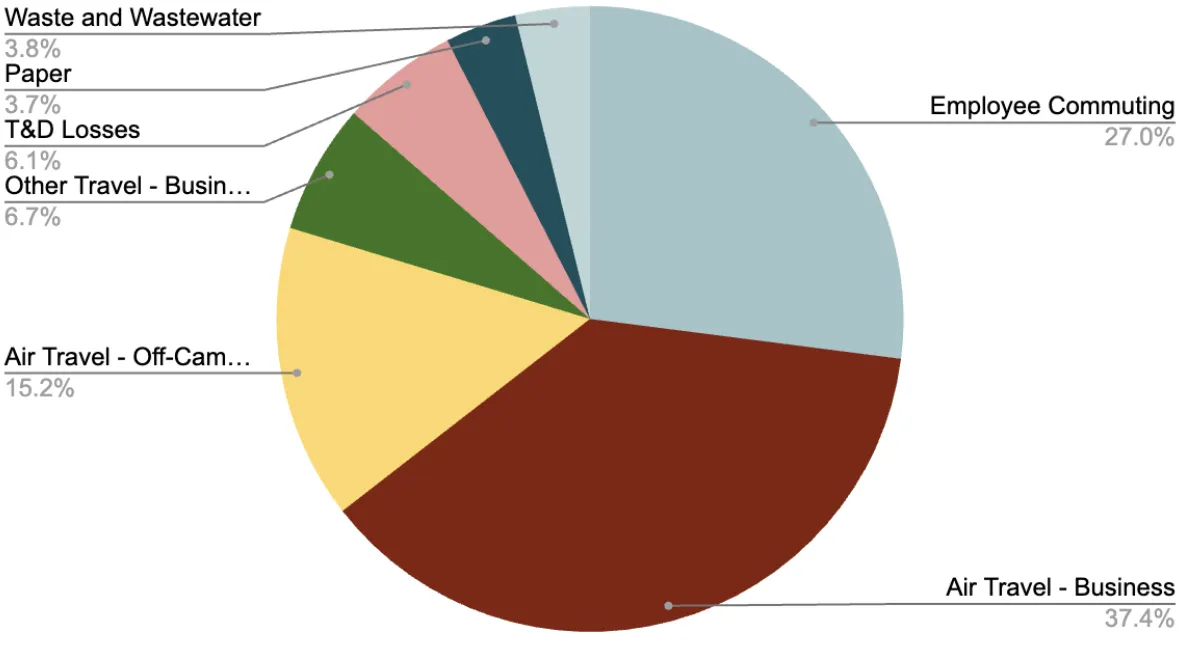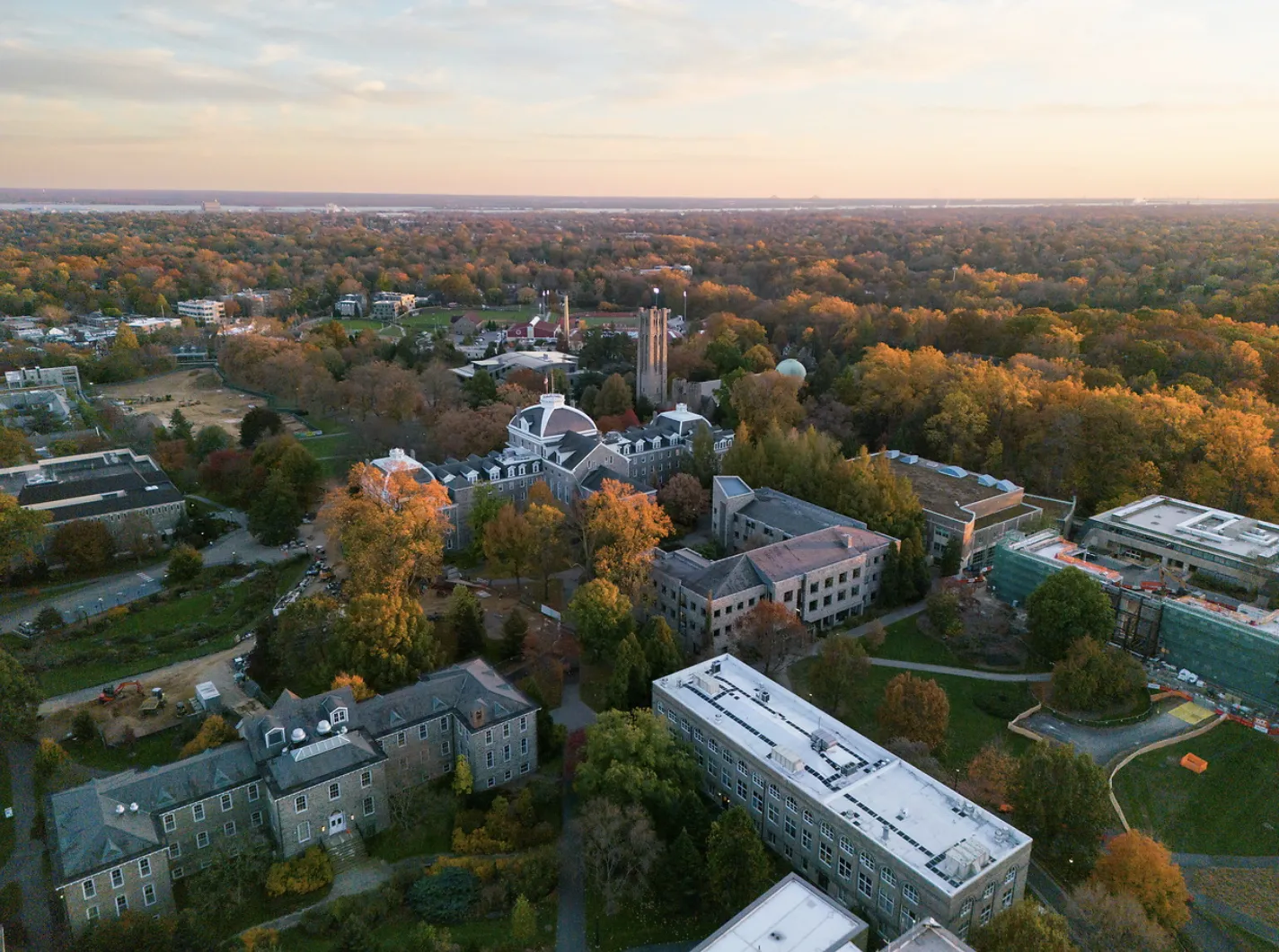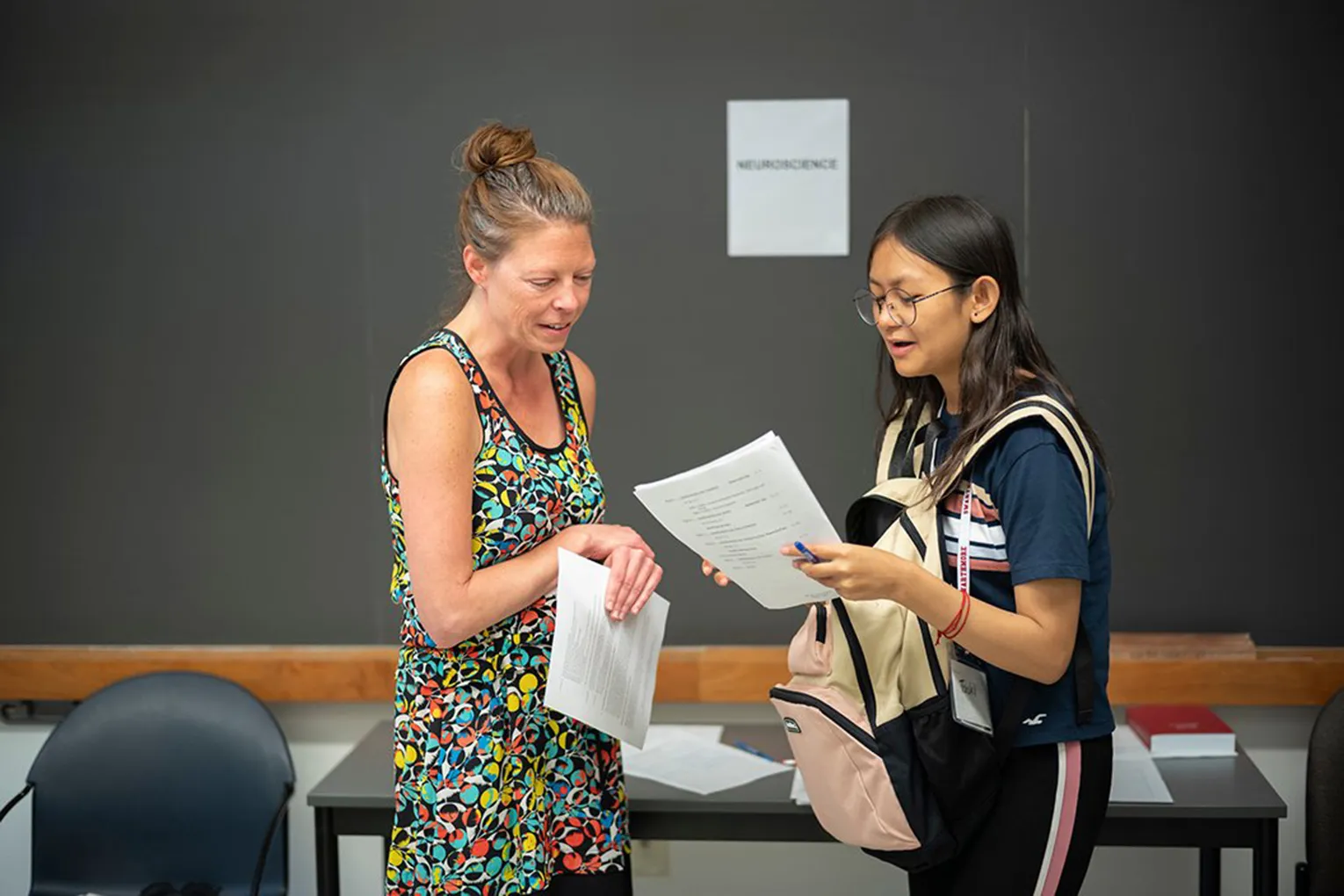Sustainable travel is all about making conscious decisions to lessen the negative impact that travel has on the environment. By using these guidelines when planning, booking, and participating in College travel, we can make meaningful progress in reducing our collective carbon footprint in support of achieving carbon neutrality at Swarthmore College by 2035.
Our Travel Impact
In 2024, indirect emissions (also known as Scope 3) from transportation which includes commuting, air travel and business travel produced about 27% of the College’s carbon emissions. Air travel, including flights related to business and off-campus study, accounts for roughly 60% of that total. Staff and faculty commuting comprise another 8.49%, and other college-financed travel rounds out the final 2.11% of emissions from transportation. The other primary emissions sources at the College are Scope 1 emissions from natural gas combustion and Scope 2 emissions from electricity procurement.

Reduce Travel
The most effective way to reduce the climate impact of travel is to travel less. While travel is a critical component of many College programs and job functions, there are ways to make travel more efficient and reduce the overall amount of necessary travel:
- Virtual Meetings or Conferencing
Recently, there has been a tremendous shift towards virtual work, driven largely by the COVID-19 pandemic that forced us to rethink how we travel and connect. While in-person meetings are necessary for some functions, many of the same outcomes can be accomplished with virtual meetings on platforms like Zoom. Before planning a trip, think about whether it could be conducted virtually to reduce unnecessary emissions from travel. This would help to reduce preventable travel, which can lead to an increase in carbon emissions. This is also more economically conscious as well as the cost of room accommodations and activities is lessened.
- Combine Multiple Trips
When planning your trip, try to make your trips as efficient as possible, especially if you have multiple meetings or events in the same region. Consider traveling directly from one location to the next, rather than returning home and then traveling to your next destination.
- Consider a Carbon Budget
Consider the facts - Individuals or departments may find it helpful to think about actions, including travel options, in the context of a carbon budget. A carbon budget is the maximum amount of emissions that can be generated to avert the worst impacts of climate change. According to Our World in Data, the average person in the United States emits about 16.01 tons of carbon dioxide equivalent (CO2e) per year. However, in order to limit global warming to below 2°C, the average person will need to generate fewer than about 4.5 tons in 2030. Most climate scientists agree that even 2°C of warming is too much and that we should instead aim to reduce total warming to less than 1.5°C.
Travel choices can contribute a significant amount to a carbon budget. For example, one round-trip flight from Philadelphia to Europe or San Francisco produces the equivalent of about 2-3 tons of CO2e per person. Decisions around travel, including whether or not a trip is necessary, can make a big difference to our collective carbon footprint.
Check out this carbon travel calculator, which calculates the emissions from your air travel.
Local Travel
For some faculty and staff, as well as a few students, traveling to and from Swarthmore is a large fraction of their annual travel. The following best practices are general guidelines for making local travel, including commuting, more sustainable:
- Walk or Bike
When possible, walk or bicycle to and from Swarthmore. Human-powered travel is by far the most sustainable and least carbon-intensive method of commuting. In addition, walking or bicycling for just a few minutes per day can have measurable health impacts. And it’s free!
- Public Transportation
In general, commuting by train or bus is less carbon-intensive than driving. In many cases, it’s also less expensive, safer, and leaves more time to read the morning news.Swarthmore students have access to SEPTA free of cost, and faculty and staff have access to SEPTA at a subsidized rate, further incentivizing the use of public transportation. Swarthmore College participates in the Commuter Benefits Program, which allows employees to have pre-tax dollars deducted from their paycheck to purchase public transportation vouchers.
- Carpool
Reach out to colleagues to inquire about carpooling: you may be surprised at how convenient and economical it can be to share a ride. Reach out to colleagues atSwarthmore or other local institutions when attending a local or regional conference.
- Drive fuel-efficient or electric vehicles
If you must drive a car, using a fuel-efficient vehicle can save money and reduce carbon emissions. Electric vehicles are particularly appealing for sustainability reasons because they get less carbon-intensive as the overall electricity grid becomes cleaner. Already, electric vehicles produce far less carbon than almost all other combustion vehicles. For personal use, the College has numerous electric vehicle charging stations available on campus. For business-related travel, consider using the Swarthmore fleet or recommended vendors (see the Swarthmore Fleet Management webpage).
Long Distance Travel
Reducing long-distance travel is one of the most impactful ways to reduce your carbon travel footprint. The following best practices will help mitigate the remainder of travel that is absolutely essential:
- College-approved travel agent
Use a College-approved travel agent to purchase flights. Some travel agents display carbon emissions data as part of the online booking system, helping the College to accurately track emissions from air travel. To use one of the College’s currently contracted travel agents, contact the Director of Procurement at the Business Office.
- Pack Light
Pack based on necessity and practicality; carrying less weight contributes directly to reduced fuel consumption, thereby lowering emissions.
- Nonstop Flights
Book non-stop flights when possible. Airplanes produce more emissions during takeoff and landing than during the flight itself, so booking non-stop flights decreases your carbon footprint.
- Consider Alternatives to Air Travel
For travel to destinations less than 300 miles away, consider alternatives to air travel. Trains and buses may take a few hours longer, but in many cases, they offer a more comfortable and convenient experience, in addition to the sustainability benefits.
- Low Emissions Flight Options
If you are booking air travel on your own, pick the lowest emissions flight option. When using an airline’s website, a travel agency, or other search engines, you can sort flight options by their estimated carbon emissions and choose the lowest emissions option. And if using a travel agent, ask the travel agent to provide the lowest emissions flight options.
Offset Travel
After reducing travel and choosing to travel more sustainably, a third option for reducing our climate impact is to purchase carbon offsets. A carbon offset is a reduction in emissions of carbon dioxide or other greenhouse gases made in order to compensate for emissions made elsewhere. Offset projects reduce emissions outside an entity’s boundaries, producing credits that can be purchased by the entity to meet its own targets for reducing emissions within its boundaries. Offsets fit into the College’s carbon neutrality strategy as the final step after eliminating and reducing all other carbon emissions outlined in our greenhouse gas inventory.
The Office of Sustainability currently purchases offsets to cover all emissions associated with business air travel. With the help of programs like the Air Travel Carbon Fee, the College can pursue high-quality verified offsets while encouraging behavior that reduces scope 3 emissions. Individual faculty and staff members should not be buying offsets with department funds as offset purchases are centrally organized through the Office of Sustainability.




